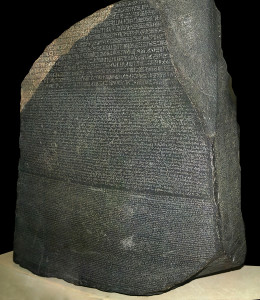
During the late 18th century and the early 19th century Napoleon Bonaparte was France’s Emperor and a great military leader who conquered many European nations. He was brilliant, not only as an Emperor and military leader, but he was also interested in antiquity (defined as something belonging to or remaining from ancient times). When he was planning his Egyptian Campaign to defeat the British, he was also aware that little was known of the Egyptian culture, so he decided to take non-military personnel to explore for antiquities. These civilians were prominent experts of their time such as artists, botanists, geologists, geographers, historians and linguists, hoping to unlock some of the secrets of the ancient world, as they could not understand the hieroglyphs of the Pharaoh’s tombs and the monuments found in Egypt. It was a dead language that had not been used for at least eight centuries. The common thought during Napoleon’s time was that it was pictures of events, but the scientists could not make sense of the pictures and what they were trying to relate. The monuments amazed the modern world – what type of advanced technology was used for construction and what were they telling us? It was a mystery that Napoleon hoped to solve. During the summer of 1799, the French army was in Egypt stationed at Fort Julien in close proximity to the city of Rashid, also referred to as Rosetta. The army was expanding the fort and, in the process, was removing an ancient wall. During the demolition, an officer discovered a large stone with three different ancient writings upon it. The stone was named the Rosetta Stone. It was a monument built into the wall and it weighed three-quarters of a ton. It was carefully extracted and then sent to Cairo to the Institute of Egypt to begin researching the stone, but military matters intervened – the Treaty of Alexandria. The part of the treaty that dealt with the antiquities the French had discovered demanded them to be turned over to the British. By 1802, the Rosetta Stone was located in the British Museum. The stone is inscribed with a decree issued at Memphis, Egypt, in 196 BC on behalf of King Ptolemy V. The decree appears in three scripts: Ancient Egyptian hieroglyphs, Demotic script and Ancient Greek. Because it presents essentially the same text in all three scripts (with some minor differences among them), the stone provided the key to the modern understanding of Egyptian hieroglyphs. Carved in black granodiorite, the stone is believed to have originally been displayed within a temple. It was probably moved during the early Christian or medieval period, and was eventually used as building material in the construction of Fort Julien. Two scholars are credited with deciphering the stone – Thomas Young and Jean-Francois Champollion. The British Museum has housed the Rosetta Stone since 1802, but after 214 years in the United Kingdom, Egypt wants it back. What will happen? Only time will tell.
Photo by Hans Hillewaert / Downloaded from Wikipedia.
